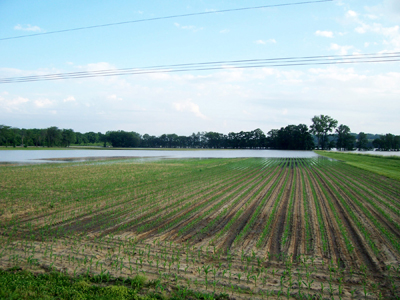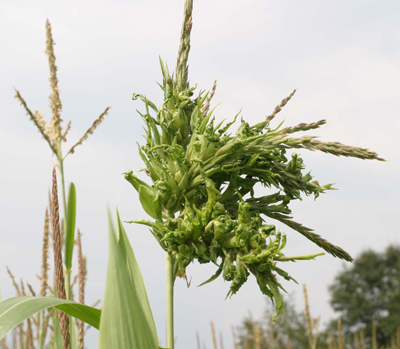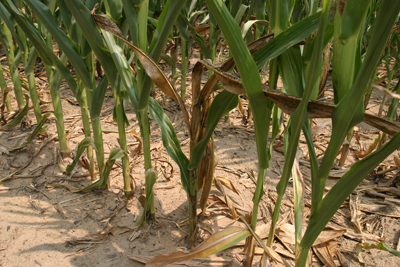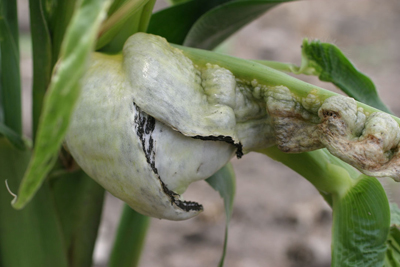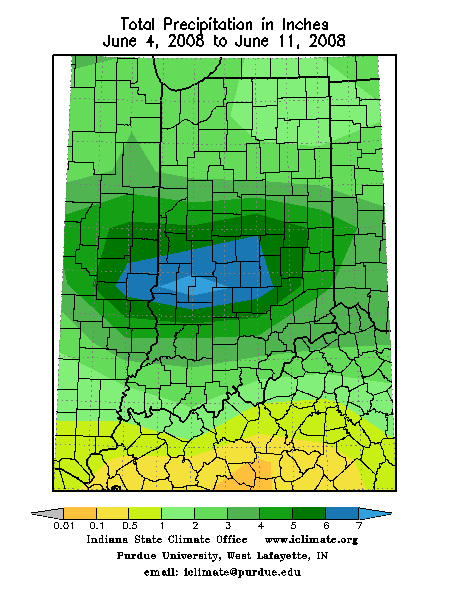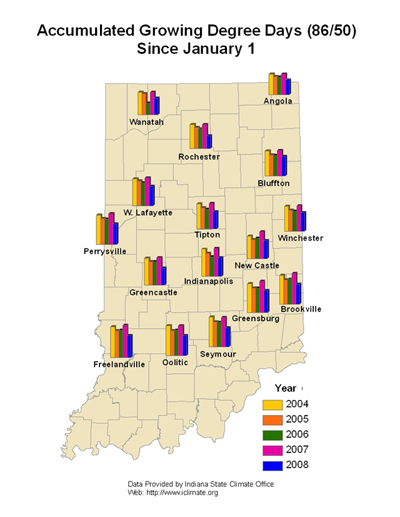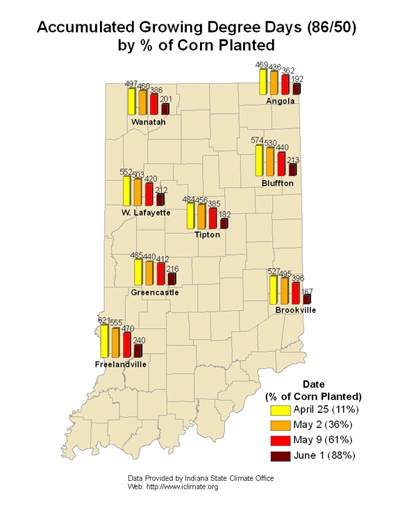Pest & Crop Newsletter, Entomology Extension, Purdue University
- Should a Rootworm Soil Insecticide Be Used on Late Planted or Replanted Corn?
- Replanting Corn and Rootworm Control Restrictions
- Corn Earworm Arriving Early, Must Like August-Like Conditions
- Armyworm and Slugs, Here and There
- Black Light Trap Catch Reports
- Tillage System Choices for June Planting or Replantng After Flooding
- Replant Considerations for Flooded Corn
Should a Rootworm Soil Insecticide Be Used on Late Planted or Replanted Corn?– (John Obermeyer and Larry Bledsoe)
- Rootworm hatch is not complete.
- If warranted, a soil insecticide should still be used for another week for rootworm control in fields yet to be planted.
- Reapplication of insecticide may be needed in fields to be replanted.
Rootworm larval hatch, as reported in last week’s Pest&Crop, has begun throughout the state and peak hatch is occurring about now, plus or minus a few days from south to north. This means that conventional corn (not rootworm resistant) yet to be planted, or replanted will have a reduced risk of rootworm damage, because of being on the tail end of hatch. Unfortunately, there is still a risk.
Rootworm eggs can survive this flooding, larvae cannot
(Photo Credit: Dennis Nowaskie, SWPAC)
Rootworm larvae that have already hatched in unplanted fields will have starved without grass roots to sustain them. However, eggs yet to hatch, or recently hatched larvae that found grasses (e.g., foxtails, volunteer corn, etc.) on which to survive, are a potential threat. Our recommendation on conventional corn yet to be planted, through the third week of June, is for producers to continue with their planned rootworm control program. After that time, low rates of seed-applied insecticides (i.e., Cruiser, Poncho) should be sufficient for any remaining larvae that hatch.
For replanting, even if a soil insecticide was used on the original planting, producers should consider reapplying a rootworm insecticide as part of the replanting operation (refer to the following article for label restrictions). Reapplications may be of greatest benefit for planting that originally occurred in April and early May. This is especially true because high amounts of rainfall and ponding have likely moved the insecticide out of the root zone area and/or enhanced the degradation of the product. Even if the insecticide is still present in sufficient quantities to control rootworms, it may be difficult to place the seeds in the previous insecticide band.
![]()
Replanting Corn and Rootworm Control Restrictions - (John Obermeyer and Larry Bledsoe)
Soil insecticides have restrictions as to the amount of product that can be applied per season as stated on the label. Because the label is the law, this is not to be exceeded. Most soil insecticide rates restrict application to one per season. Lorsban 15G (4E) can be legally reapplied if you observe the 16-ounces per 1000 ft. of row (6 pints per acre) per season limit. The seed-applied insecticides (SAI), Cruiser and Poncho, can also be reapplied. The bottom line is that, if you choose to reapply a soil insecticide during replanting, it should be a different active ingredient from what you used the first time (exception is Lorsban and SAIs). Remember, your granular insecticide boxes will have to be recalibrated for the new product since all products are formulated differently.
| Product | Replant Restriction at Rootworm Rate (Use Same Product Again?) |
| Aztec 2.1G & 4.67G | Don't |
| Capture 2EC & LFR | Don't |
| Counter CR & 15G | Don't |
| Cruiser (rootworm rate) | Yes |
| Force 3G & CS | Don't |
| Fortress 3.5G and 5G | Don't |
| Furadan 4F | Don't |
| Lorsban 15G & 4E | Yes |
| Poncho 1250 (rootworm rate) | Yes |
| Regent | Don't |
![]()
Corn Earworm Arriving Early, Must Like August-Like Conditions – (John Obermeyer and Larry Bledsoe)
Rick Foster, Purdue vegetable/fruit extension entomologist, decided to begin pheromone trapping for corn earworm just before the last rash of storms. After wading out to his trap this morning (June 11) he was astounded to find 178 moths captured. Because the moths were pretty beat-up, he suspects they have been driven here from the southern states on recent moisture-laden fronts. In checking with other trappers in the Midwest, they too captured an inordinate number of moths during the same time period. See the 2008 corn earworm pheromone trap catches <http://extension.entm.purdue.edu/cornearworm/index.php>.
Moth numbers this high are not normally seen in the Midwest until August when hurricanes affecting the Gulf States push moths this way. Concerning field crops, we’re uncertain of the potential impact at our present crop stage. Earworm have been known to occasionally infest very late-planted corn in the whorl stage, and just like fall armyworm create quite a mess in a few plants here-and-there. Documentation of infestations of early-whorl stage corn is lacking in the Midwest.
Consider this as a heads-up. Perhaps the whorl feeding and/or leaf defoliation, seen even in some Bt-Corn, might be corn earworm. Certainly would be a “Kodak” moment. Happy scouting!
![]()
Armyworm and Slugs, Here and There – (John Obermeyer)
Brad Kohlhagen, Adams County CES, indicated that armyworms are “marching” in and around wheat fields, much to the consternation of homeowner’s with infested lawns. We in agriculture love to share with our city neighbors! Jonathan Ferris, Fayette County CES, reported a replanted no-till soybean field being destroyed by slugs. Options for controlling slugs in the third replant are limited to tillage or pelleted-metaldehyde baits. At this point in time, I would be reluctant to choose expensive and difficult to spread baits that don’t always work.
![]()
Considerations for Replanting Soybean in Drowned Out Corn Fields – (Bill Johnson and Glenn Nice)
The recent heavy rains have resulted on lots of standing water and drown out areas in corn and soybean fields. Many of these areas will require replanting. A major consideration on whether to replant soybean in a field that was in corn is the rotational restrictions for corn herbicides. Table 22, follow link below, lists the rotational restrictions of the herbicides in the Weed Control Guide for Ohio and Indiana (pages 189-190). The only herbicides labeled for use in corn which would allow replanting soybean immediately are Prowl and Python. All other soil-applied corn herbicides have a several month rotational interval which must elapse before soybean can be planted. Most of the postemergence herbicides have shorter rotational intervals, but would still require a couple of weeks before soybean can be planted.
Table 22. Restrictions on Crop Rotation <http://www.btny.purdue.edu/Pubs/WS/WS-16/HerbCropRot.pdf>
Recent Weather May Promote Unusual Disease Problems in Corn - (Gregory Shaner)
- High water creates conditions for crazy top and bacterial stalk rot.
- Strong winds can lead to corn smut.
Excessive rain and strong winds during the past 2 weeks may result in diseases that are normally minor issues for corn: crazy top, bacterial stalk rot, and smut.
Crazy top belongs to a class of diseases known as downy mildews. The most conspicuous symptom of crazy top is a leafy proliferation in place of the normal tassel. Infected plants tiller excessively. Leaves are only about one-third normal width. Leafy bracts may develop on the ears. Plants may be severely stunted. Most importantly, infected plants are usually barren. A fungus-like organism, Sclerophthora macrospora, causes crazy top. This organism infects several grasses, including crabgrass, barnyard grass, goose grass, green foxtail, love grass, smooth brome, quack grass, and witch grass, that may be along field edges. These grass hosts are probably the source of spores that infect corn. That is why crazy top usually appears only on corn near field edges. Sclerophthora produces oospores in infected tissue. These spores overwinter. When soil is saturated or flooded for at least a couple of days, oospores germinate to produce a sporangium, which in turn releases small, motile zoospores. Zoospores that come in contact with corn or some other host plant encyst and then infect. Corn is most vulnerable to infection when young. When Arni Ullstrup described this disease in 1955, he observed that when plants were over 1 foot tall when flooded, crazy top did not develop. The delays in planting corn this spring, and the cool weather that slowed growth of corn, means that many ponded fields are still at a vulnerable growth stage.
Crazy top symptoms on the tassel. Most of the tassel has been replaced by a leaf proliferation.
Flooding also increases risk of bacterial stalk rot. Erwinia carotovora pv. zeae causes this disease. The bacterium survives in aboveground corn residue. It infects corn when contaminated water moves into whorls of young plants. The bacterium produces a soft rot at the base of the whorled leaves. These leaves become yellow, then brown, and they can be pulled out of the whorl easily. The bacterium invades the growing point and produces a soft, often foul-smelling rot. We have seen this disease in previous years where corn was sprinkler-irrigated from ditch water or where corn was briefly inundated by floodwater. The warm and excessively wet weather of the past few days may lead to outbreaks of bacterial stalk rot in fields where water covered the whorl. Temperatures in the range of 90 to 95°F are most favorable for the disease, and we have experienced these over the past few days. Where floodwater recedes quickly enough that corn does not die outright, this disease may develop. Not every plant that is flooded will develop the disease, but the incidence may be high enough to reduce yield.
Bacterial stalk rot. Abov two green leaves on the lant in the center of the picture, all leaves are dead. The rot has progressed down into the crown tissue. Even though all lants in this field were exposed to contaminated irrigation water, only some became infected.
Soil particles carried by strong winds during the past several days may have caused microscopic wounds to young corn plants, which will allow spores of the common smut fungus (Ustilago maydis) to infect. Teliospores of the fungus survive several years in soil, and the fungus appears to be widespread in Indiana. It is possible to find a few smutted corn plants in any field that is walked, but the incidence of infection is usually so low there is no economic damage. However, very susceptible hybrids may develop a high incidence of smut and suffer considerable loss. Last year I looked at a field planted to four different hybrids. In one hybrid, 50% of the plants had smut galls. This was before ears had emerged. The galls were on the lower stem and so large they had broken the stalks over. The other three hybrids had smut, but at much lower incidence, and galls were small and mainly on leaf blades.
Spores infect stems and leaves through microscopic wounds. The fungus may also grow down silks and infect developing kernels, which results in ear galls. Initially the galls are smooth and white. Later, the interior of the gall becomes a mass of black spores, and then the covering white tissue disintegrates to release the spores. Wet weather is thought to favor spore production and infection. With the strong winds we have had recently, followed by humid weather, we may see more than the usual amount of smut on corn.
Young gall on the lower stem of a susceptible hybrid.
Older gall on lower stem of a susceptible hybrid. Black spores are starting to break
through the white covering. Note: that the stalk is bent over at a right angle.
Tillage System Choices for June Planting or Replanting After Flooding – (Tony J. Vyn)
Farmers who decide to replant ponded areas or even entire fields that were flooded (and where the stand loss justifies replanting on an economic basis) will want to do so with as little tillage as possible. In most field situations, intensive tillage does not make sense because of the additional cost and time that it will take as well as the risk of creating cloddy seedbeds that limit seed germination. Most often, the preferred tillage system for June planting would be no-till. However, there are some no-till adjustments that might be helpful, and there are some unique situations were some tillage might be justified. Here are some tips for tillage and planting decisions for such late planting situations.
1. No-till normally makes the most sense. With warm air and soil temperatures during most of June, yield differences between tillage system are even less than they could be with April planting. For example, while tillage might improve yields on certain soils when corn is planted in April following corn, no-till corn should equal conventional tillage corn when farmers plant in June.
2. Consider compromises to the “ideal” seedbed moisture condition. Although it is preferable to wait until the surface 2 inches of soil are dry enough to avoid sidewall compaction with planter disk openers, the reality is that corn and soybean yield losses grow with each passing day. If farmers are confident that weekly rainfall will occur for the first 3 weeks after their June planting, then some sidewall compaction can be tolerated with little negative effects on yield. However, if hot and dry weather conditions are expected, it would be foolish to “smear” the seed in.
3. Use minimum down pressure on the row units and seed closing wheels. Soils that have been saturated for some time tend to have excess moisture below seed depth. Compaction of those layers with high down pressures can cause problems for root expansion later in the season. The objective in setting down pressure is to use the least pressure required to get sufficient penetration of the seed disk opener, constant seed depth, and adequate closure of the seed furrow. Higher pressures don’t improve things, and may be harmful (particularly for soybean).
4. Consider tools to aid soil drying before planting. Superficial tillage (with shallow harrows, coulters and/or rolling baskets) may be helpful to speed up the rate of surface soil drying in cases with matted surface residue or crusted soil. Such tools may not improve otherwise no-till corn or soybean yields, but may advance planting by one or two drying days.
5. Recognize the consequences of flooding to soil structure. Soils that have been wet for some time are always the soils most vulnerable to forming clods when they are tilled. Soils that have gone through several wetting and drying periods in normal precipitation intensities will have much better tilth or friability than soil that dries for the first time following a week or more of saturation. So the risk of doing tillage following flooding in June is that the soil is so non-friable that large clods will form easily (especially in the tractor wheel tracks) and that seed to soil contact will be compromised. Cloddy seedbeds are most likely on soils with high clay and low organic matter contents following crops which don’t enhance soil aggregate stability (e.g. following soybean). Similarly, the potential of soil crust formation (and restriction to seedling emergence) following June tillage operations is even more likely than in no-till situations.
6. Avoid thinking of tillage as the only way deal with herbicide resistant crops. Farmers using glyphosate-resistant soybean following their earlier 2008 planting of glyphosate-resistant corn may first think of tillage as an expedient method to control these surviving herbicide resistant “volunteer” plants. However, tillage may be more costly (in terms of compromising seedbed quality and delayed planting) than other herbicide options. For additional herbicide versus tillage methods to control the glyphosate-resistant corn, see the recent article by Johnson and Nice (2008).
7. Try to spray burndown herbicides as early as possible. Controlling weeds is essential to improve the evaporation rate at the soil surface, and achieving early weed control is more essential for reduced tillage planting situations in June than in April. However, the presence of very tall weeds because of excessive rainfall in May, as well as the recent rains in the first week of June, may limit certain herbicide control options and force some tillage in what earlier might have been candidate fields for no-till cropping.
8. Keep any tillage operations shallow. Deep tillage will only go into wetter soil conditions, and involve more compaction and clod formation risk. June tillage pre-planting operations should never be deeper than 3 inches.
9. Automatic guidance is helpful. In re-planting situations, automatic guidance (and particularly the most accurate RTK system) assists farmers planting their rows precisely. This will be an advantage where the June crops might still pick up starter fertilizer benefits from the first planting operation, and would also be helpful in avoiding planting directly over any recently side-dressed nitrogen bands.
10. Remember where the poorly drained areas are. Once late planting is completed, it might be helpful to consider the adequacy of drainage in these areas. No field drainage system can ever be sufficient for 10 inch downpours, but additional drainage may limit the size of areas requiring replanting this year, and would also improve the odds of success with no-till and strip-till cropping systems.
There is never any true satisfaction in planting or replanting full-season crops this late in June. It is rather like trying to make the best of a very challenging situation. But intensive tillage is rarely required, and mostly involves more risks for farmers planting in June. Properly managed no-till is usually the best choice.
Reference
Bill Johnson and Glenn Nice. 2008. Methods to Control Volunteer Roundup Ready or Glyphosate - Tolerant Corn in a Corn Replant Situation. Pest and Crop Newsletter Issue 10 (June 6) <http://extension.entm.purdue.edu/pestcrop/2008/issue10/index.html>.
![]()
Replant Considerations for Flooded Corn – (Bob Nielsen)
Ponded or flooded crop fields in early to mid-June are not a desirable sight for growers and ag. industry alike. Growers must decide on management options that best minimize their potential losses in income and yield while the ag. industry scrambles to meet the anticipated demand for replant seed and other inputs required by their customers over the coming weeks. All of this falls in the middle of the time period that is already busy with applications of sidedress nitrogen and post-emergence herbicide.
I and several of my colleagues at Purdue and elsewhere have addressed some of the key issues related to flooded crops (Johnson & Nice, 2008; Nielsen, 2008a; Nielsen et al., 2008; Pedersen, 2008a; Pedersen, 2008b; Shaner, 2008; Vyn, 2008). Let me address a few more issues specifically related to replanting options for flooded cornfields.
Crop Insurance Considerations
Growers who have purchased crop insurance and are interested in replanting damaged cornfields or parts of fields at this late date should first consult with their crop insurance agent to determine the ramifications of a replant decision on their insurance coverage or payout. Crop insurance policies can vary greatly in their impact on replant decisions farmers may make (Patrick, 2008).
Replanting Back to Corn
Replanting damaged cornfields back to corn is becoming an increasingly uncertain choice, especially for growers in the northern two-thirds of Indiana because of the rapidly shortening growing season and the prospects for significantly lower yield potential. Some folks, though, may feel obligated to replant to corn for various reasons (nitrogen already applied, herbicide already applied, landlord’s insistence, etc.).
Tables 1 & 2 list the approximate “safe” relative hybrid maturities that could be planted over the coming weeks throughout Indiana. The two tables differ according to the date by which you want to target physiological maturity of the crop and its relationship to the date by which a killing fall frost typically occurs. Table 2 is more conservative; meaning that the listed hybrid maturities are earlier than those in Table 1 and thus will more likely mature safely prior to a killing frost this fall. See my earlier article for more background information on how these hybrid maturity estimates are determined (Nielsen, 2008b).
| Approx. "safe" relative maturities for late planting dates in Indiana with assumption that the hybrid will mature the week of expected fall frost date. | |||||
Crop Rpt District |
"Typical" CRM |
Expected Fall Frost Date |
Planting Date... |
||
14-June |
21-June |
28-June |
|||
Approx. "safe" relative maturity |
|||||
NW |
109 |
6-Oct |
102 |
99 |
95 |
NC |
109 |
6-Oct |
102 |
98 |
94 |
NE |
109 |
6-Oct |
100 |
96 |
92 |
WC |
112 |
13-Oct |
112 |
107 |
103 |
C |
112 |
13-Oct |
109 |
105 |
101 |
EC |
109 |
6-Oct |
102 |
99 |
95 |
SW |
116 |
20-Oct |
118+ |
118+ |
115 |
SC |
113 |
13-Oct |
116 |
112 |
107 |
SE |
113 |
13-Oct |
117 |
113 |
108 |
50 PCT Fall Frost Risk Date |
|||||
| Approx. "safe" relative maturities for late planting dates in Indiana with assumption that the hybrid will mature the week of expected fall frost date. | |||||
Crop Rpt District |
"Typical" CRM |
Expected Fall Frost Date |
Planting Date... |
||
14-June |
21-June |
28-June |
|||
Approx. "safe" relative maturity |
|||||
NW |
109 |
6-Oct |
100 |
96 |
92 |
NC |
109 |
6-Oct |
99 |
96 |
91 |
NE |
109 |
6-Oct |
97 |
94 |
90 |
WC |
112 |
13-Oct |
109 |
105 |
100 |
C |
112 |
13-Oct |
107 |
103 |
98 |
EC |
109 |
6-Oct |
100 |
96 |
92 |
SW |
116 |
20-Oct |
118+ |
117 |
112 |
SC |
113 |
13-Oct |
113 |
109 |
104 |
SE |
113 |
13-Oct |
114 |
110 |
108 |
50 PCT Fall Frost Risk Date |
|||||
The challenge for many growers in this regard will be that the suggested hybrid maturities are less adapted to their areas of Indiana than normal full-season hybrids, especially in terms of disease resistance, and thus must be considered with great caution. Secondly, the seed availability of these early maturity hybrids will undoubtedly be limited and so growers ought to be talking with their seed dealers now if they anticipate replanting damaged areas.
One of the frustrating issues with making a replant decision this late in the season is that there is essentially no data-based information we can rely on to estimate yield potential for corn replanted in late June. The tabular information we usually rely on is that from the Univ. of Illinois (reproduced below in Table 3), but it only extends through the first week of June. Based on conversations with a number of colleagues, most of us believe that corn planted in late June would yield approximately 50% of that planted in “normal” planting periods (assuming the corn matures safely prior to a killing fall frost). However, coupled with current high corn grain prices, even that low of a yield prospect may be worth the risk for some growers.
Be aware that corn replanted late, especially if replanted into a flooded pocket within a field, will be very attractive to corn rootworm beetles during pollination. Growers should monitor such replanted areas near pollination and be prepared to apply foliar insecticides if warranted. One positive note is that, compared to the pre-biotech era, today’s hybrids that carry the Bt-corn borer trait greatly reduce the yield-robbing effects of European or southwestern corn borer insects in late-planted corn.
Replanting Back to Soybean
Some growers will choose to forego replanting damaged cornfields back to corn in favor of replanting back to soybeans instead, even if they have already applied corn herbicides and/or nitrogen fertilizer. Recognize that while the choice to replant damaged cornfields back to soybeans is the prerogative of the grower, the risk of damage to the soybean crop from previously applied corn herbicides is borne solely by the grower because most soil-applied corn herbicides have more than a few months’ crop rotation restriction on their labels (Johnson & Nice, 2008). Recognize that seed supply for replant soybean will also be in short supply. At the least, growers will likely not be able to purchase their first choice of a soybean variety.
Replanting Back to Grain Sorghum
Growers interested in replanting damaged cornfields to grain sorghum should consult the article we published recently (Nielsen et al., 2008). Please recognize, however, that if you have never before grown that crop, doing so under a crisis mindset may not be the best time to learn the ins and outs of that crop. I’ve also been told that seed supply of that crop will be in short supply.
Replanting Back to Summer Forage
Some growers may elect to replant damaged cornfields or parts of fields to one of several types of summer forage species to be harvested later to supplement anticipated shortages of normal forage supplies. Contact my forage colleague, Keith Johnson <johnsonk@purdue.edu>, for more information on this opportunity.
Related References
Johnson, Bill and Glenn Nice. 2008. Considerations for Replanting Soybean in Drowned out Corn Fields. Purdue Extension Weed Science. [On-line]. Available at <http://www.btny.purdue.edu/weedscience/2008/DrownedCorn08.pdf>. [URL accessed 6/10/08].
Nielsen, R.L. (Bob). 2008a. Effects of Flooding or Ponding on Young Corn. Corny News Network, Purdue Extension. [On-line]. Available at <http://www.kingcorn.org/news/timeless/PondingYoungCorn.html>. [URL accessed 6/9/08].
Nielsen, R.L. (Bob). 2008b. Late Planting/Replanting & Relative Hybrid Maturity. Corny News Network, Purdue Extension. [On-line]. Available at <http://www.kingcorn.org/news/2008/DelayedPlt_Hybrids.html>. [URL accessed 6/11/08].
Nielsen, R.L. (Bob). 2008c. More Thoughts on Late Corn Planting. Corny News Network, Purdue Extension. [On-line]. Available at <http://www.kingcorn.org/news/2008/DelayedPltUpdate-0523.html>. [URL accessed 6/11/08].
Nielsen, R.L. (Bob), Bill Johnson, & Glenn Nice. 2008. Grain Sorghum Considerations for Late Planting in Southern Indiana. Corny News Network, Purdue Extension. [On-line]. Available at <http://www.kingcorn.org/news/timeless/LatePlantGrainSorghum.html>. [URL accessed 6/9/08].
Patrick, George. 2008. Decisions await farmers with crop insurance, economist says. Purdue Univ. News. [On-line]. Available at <http://news.uns.purdue.edu/x/2008a/080610PatrickInsurance.html>. [URL accessed 6/11/08].
Pedersen, Palle. 2008a. Effect of Flooding on Emerged Soybeans. Integrated Crop Management News, Iowa State Univ. [On-line]. Available at <http://www.extension.iastate.edu/CropNews/2008/0531PallePedersen2.htm>. [URL accessed 6/9/08].
Pedersen, Palle. 2008b. Soybean Replant Decisions from Hail Damage and Flooded Fields. Integrated Crop Management News, Iowa State Univ. [On-line]. Available at <http://www.extension.iastate.edu/CropNews/2008/0531PallePedersen.htm>. [URL accessed 6/9/08].
Shaner, Greg. 2008. Recent Weather May Promote Unusual Disease Problems in Corn. Corny News Network, Purdue Extension. [On-line]. Available at <http://www.kingcorn.org/news/timeless/FloodingDisease-0610.html>. [URL accessed 6/10/08].
Vyn, Tony. 2008. Tillage System Choices for June Planting or Replanting after Flooding. Corny News Network, Purdue Extension. [On-line]. Available at <http://www.kingcorn.org/news/timeless/FloodingTillage-0610.html>. [URL accessed 6/10/08].
Decisions Await Farmers With Crop Insurance, Economist Says – (Writer: Steve Leer, Source: George Patrick)
WEST LAFAYETTE, Ind. - Indiana farmers who insured their 2008 crops have decisions to make if recent floods damaged their cropfields, said a Purdue University Extension agricultural economist.
“In some instances, farmers may not have been able to plant their original crop in a timely manner, and in other instances farmers have lost crops due to flooding,” George Patrick said. “These producers, if they have followed good farming practices, may be eligible for different crop insurance benefits depending on the type of insurance they have and their individual circumstances.”
Producers prevented by weather from planting their intended crops on time have three options, Patrick said.
“They can go ahead and plant the original crop even though the yield may be reduced,” he said. “Second, they can plant an alternative crop, such as shifting from corn to soybeans. Or third, they can abandon the acreage and take a prevented planting payment.”
Multiple peril crop insurance plans based on a producer’s Actual Production History (APH), Crop Revenue Coverage, Revenue Assurance and Income Protection all provide a 25-day late-planting period, Patrick said.
“In Indiana, this begins June 5 for corn and June 20 for soybeans, with yield coverage levels being reduced 1 percent per day that planting is delayed, with a maximum reduction of 25 percent,” he said.
“After the late-planting period, the yield guarantee is 60 percent of the original yield guarantee level. If soybeans were included in the original insurance coverage, a producer could shift from corn to soybeans before June 20 with no reduction in the yield guarantee level.”
If planting was delayed because of weather and not by a farmer’s choice, an insured producer could choose not to plant a crop and receive 60 percent of the original yield guarantee level. “The county-based crop insurances - Group Risk Plan and Group Risk Income Plan - do not have prevented planting coverage,” Patrick said.
Farmers who planted on time and have suffered flood-related crop damage have four options available to them, Patrick said. They are:
• Leave the damaged crop as is.
• Replant part or all of the damaged area to the same crop.
• Replant part or all of the damaged area to a different crop.
• Abandon the crop and plant a cover crop.
“If the crop is left ‘as is,’ the yield, or revenue, for the insurance unit would be compared to the insurance guarantee,” Patrick said. “If the yield or revenue was below the guarantee level, an indemnity would be paid. Because many farmers insured at the 75 percent level or less, a substantial portion of the insurance unit could have a zero yield before an insurance indemnity would be paid.
“For example, a producer with an APH yield of 160 bushels per acre insured at the 75 percent level would have a yield guarantee level of 120 bushels and could suffer a complete loss on one-quarter of the insurance unit with no insurance indemnity if the rest of the unit had the 160-bushel yield. For county-based, or group, insurances, an indemnity would be paid only if the county yield was below the trigger yield specified in the insurance policy. Thus, individual producers could suffer major losses without insurance indemnities if county yields were not reduced to below the trigger levels.”
If a flood-damaged field is expected to yield less than 90 percent of the original yield guarantee level, a producer can replant to the same crop. If the area to be replanted is at least 20 acres or 20 percent of the insurance unit, then the producer may qualify for a payment equivalent to 8 bushels for corn or 3 bushels for soybeans. The county-based insurance products and catastrophic level coverage do not include a replant payment.
Should a farmer elect to replant with a second crop - such as shifting from corn to soybeans - the crop insurance company must release the flood-damaged area, Patrick said.
Patrick encouraged producers facing crop losses to work closely with their crop insurance agents.
“The claims procedures and documentation requirements need to be followed carefully,” he said. “Failure to comply with procedures could result in insurance claims being denied.”
In 2007 in Indiana, about 69 percent of the corn acreage and 66 percent of the soybean acreage was insured. Crop insurance is not available in Indiana for forage crops and some specialty crops.

